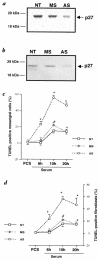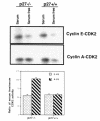Modulation of apoptosis by the cyclin-dependent kinase inhibitor p27(Kip1)
- PMID: 10074476
- PMCID: PMC408127
- DOI: 10.1172/JCI5461
Modulation of apoptosis by the cyclin-dependent kinase inhibitor p27(Kip1)
Abstract
Proliferation and apoptosis are increased in many types of inflammatory diseases. A role for the cyclin kinase inhibitor p27(Kip1) (p27) in limiting proliferation has been shown. In this study, we show that p27(-/-) mesangial cells and fibroblasts have strikingly elevated rates of apoptosis, not proliferation, when deprived of growth factors. Apoptosis was rescued by restoration of p27 expression. Cyclin A-cyclin-dependent kinase 2 (CDK2) activity, but not cyclin E-CDK2 activity, was increased in serum-starved p27(-/-) cells, and decreasing CDK2 activity, either pharmacologically (Roscovitine) or by a dominant-negative mutant, inhibited apoptosis. Our results show that a new biological function for the CDK inhibitor p27 is protection of cells from apoptosis by constraining CDK2 activity. These results suggest that CDK inhibitors are necessary for coordinating the cell cycle and cell-death programs so that cell viability is maintained during exit from the cell cycle.
Figures








Similar articles
-
Accumulation of a form of p27(Kip1) not associated with Cdk-cyclin complexes in transforming growth factor-beta-arrested Mv1Lu cells.Exp Cell Res. 2000 Aug 25;259(1):107-16. doi: 10.1006/excr.2000.4959. Exp Cell Res. 2000. PMID: 10942583
-
Akt serine threonine kinase regulates platelet-derived growth factor-induced DNA synthesis in glomerular mesangial cells: regulation of c-fos AND p27(kip1) gene expression.J Biol Chem. 2001 Sep 21;276(38):35636-43. doi: 10.1074/jbc.M100946200. Epub 2001 Jul 26. J Biol Chem. 2001. PMID: 11470779
-
A new pathway for mitogen-dependent cdk2 regulation uncovered in p27(Kip1)-deficient cells.Curr Biol. 1999 Feb 25;9(4):163-73. doi: 10.1016/s0960-9822(99)80086-4. Curr Biol. 1999. PMID: 10074425
-
Cell cycle regulation in diabetic nephropathy.Kidney Int Suppl. 2000 Sep;77:S59-66. doi: 10.1046/j.1523-1755.2000.07710.x. Kidney Int Suppl. 2000. PMID: 10997692 Review.
-
New insights into the tumor suppression function of P27(kip1).Proc Natl Acad Sci U S A. 1998 Dec 22;95(26):15158-60. doi: 10.1073/pnas.95.26.15158. Proc Natl Acad Sci U S A. 1998. PMID: 9860936 Free PMC article. Review. No abstract available.
Cited by
-
Differential regulation of cyclin-dependent kinase inhibitors in neuroblastoma cells.Biochem Biophys Res Commun. 2013 May 31;435(2):295-9. doi: 10.1016/j.bbrc.2013.04.023. Epub 2013 Apr 22. Biochem Biophys Res Commun. 2013. PMID: 23618860 Free PMC article.
-
Expression of cell cycle and apoptosis regulators in thymus and thymic epithelial tumors.Clin Exp Med. 2016 May;16(2):147-59. doi: 10.1007/s10238-015-0344-7. Epub 2015 Mar 21. Clin Exp Med. 2016. PMID: 25794494 Review.
-
Characterization of cyclin E expression in multiple myeloma and its functional role in seliciclib-induced apoptotic cell death.PLoS One. 2012;7(4):e33856. doi: 10.1371/journal.pone.0033856. Epub 2012 Apr 25. PLoS One. 2012. PMID: 22558078 Free PMC article.
-
Rosmarinic acid failed to suppress hydrogen peroxide-mediated apoptosis but induced apoptosis of Jurkat cells which was suppressed by Bcl-2.Mol Cell Biochem. 2006 Apr;285(1-2):111-20. doi: 10.1007/s11010-005-9064-8. Epub 2006 Mar 14. Mol Cell Biochem. 2006. PMID: 16534555
-
PAX7 Balances the Cell Cycle Progression via Regulating Expression of Dnmt3b and Apobec2 in Differentiating PSCs.Cells. 2021 Aug 26;10(9):2205. doi: 10.3390/cells10092205. Cells. 2021. PMID: 34571854 Free PMC article.
References
-
- Sherr CJ, Roberts JM. Inhibitors of mammalian G1 cyclin-dependent kinases. Genes Dev. 1995;9:1149–1163. - PubMed
-
- Zabludoff S, Csete M, Wagner R, Yu X, Wold BJ. p27Kip1 is expressed transiently in developing myotomes and enhances myogenesis. Cell Growth Differ. 1998;9:1–11. - PubMed
-
- Nourse J, et al. Interleukin-2-mediated elimination of the p27kip1 cyclin-dependent kinase inhibitor prevented by rapamycin. Nature. 1994;372:570–573. - PubMed
-
- Polyak K, et al. Cloning of p27Kip1, a cyclin-dependent kinase inhibitor and potential mediator of extracellular antimitogenic signals. Cell. 1994;78:59–66. - PubMed
Publication types
MeSH terms
Substances
Grants and funding
LinkOut - more resources
Full Text Sources
Other Literature Sources
Miscellaneous

